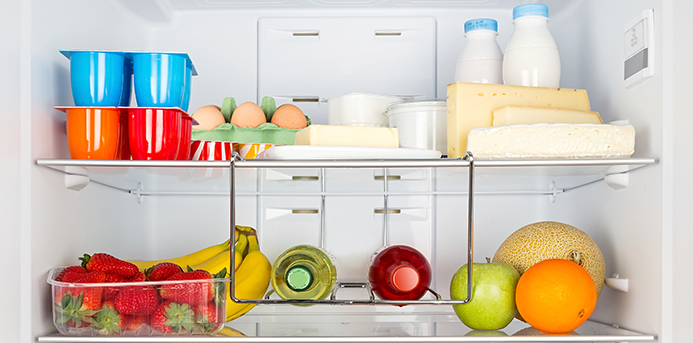It’s time to focus on the workhorse of your kitchen.
Even if you never cook, chances are your refrigerator sees plenty of action, and it needs your tender loving care.
Keep it Safe
Just because your food is stored in the fridge, doesn’t mean it’s immune to food-borne illness.
- Start with the right temperature: 40 degrees for the fridge, 0 degrees for the freezer. And since most units just give you number controls, you might want to install your own thermometer.
- Check the guidelines on how long to keep food in your fridge.
- Typically, the bottom shelf is the coldest and an ideal spot to store thawing meat so it won’t drip on fresh food below. In general, you should store raw meat, fish and poultry in sealed containers so they don’t touch or drip onto other foods.
- Clean up any spills immediately. Bacteria like listeria can still grow at normal fridge temperature. Make it a habit to wipe down any surfaces you regularly touch—handles, drawer pulls, shelves—with an antibacterial cleanser.
- Make sure you don’t overpack your fridge (think about getting a second refrigerator to store drinks and overflow from entertaining). It’s critical that there is ample airflow in your fridge to ensure proper chilling.
- No matter how fancy your unit, the door is still the warmest part of your fridge with the biggest fluctuations in temperature. Stick with condiments instead of milk or eggs.
- Don’t worry about putting warm food into your fridge, but be sure to leave it uncovered until it cools. And if you don’t get your leftovers in the fridge within two hours, pitch them.
- Remember, the pathogens that cause foodborne illness typically don’t affect the taste, smell or appearance of food.
Keep it Fresh
Most refrigerators today offer special compartments designed to ensure and enhance the freshness of food.
- There’s the meat and cheese drawer, perfect for everything from sliced ham and Parmesan to hot dogs and pâté.
- When it comes to your crisper or produce drawers, keep in mind the effects of ethylene, a natural plant hormone that causes fruit to soften. Fruits like apples, cranberries, peaches, pears, potatoes and tomatoes produce ethylene. Don’t store them in the same drawer as those foods that are sensitive to ethylene, like asparagus, broccoli, cucumbers, greens, strawberries and onions.
- When it comes to humidity settings, think low humidity for food that gets moldy, like strawberries and oranges or slimy like carrots and cucumbers. Use the high humidity setting for leafy vegetables.
- Make a weekly habit of cleaning out your fridge, disposing of any leftovers that are past their prime (see spoilage guidelines) and check expiration dates on highly perishable foods like milk, eggs, meat and poultry. The best time to do this? Right before you go to the grocery store.
- Remember, according to the USDA, typically it’s the spoilage bacteria that cause foods to develop unpleasant odors, tastes and textures—not those that cause foodborne illness. Pay attention to expiration dates.
As for the freezer, food stays safe indefinitely if kept at the right temperature. However, the government’s food safety guidelines offer quality suggestions. Make sure to use containers that seal air out and allow you to write down the contents and date stored. You’d be surprised how tomato sauce and beef stew look the same when frozen.
Keep it Organized
As much as you might be tempted to transfer all your food into neat, storage-friendly plastic containers, don’t—unless you are willing to diligently keep note of expiration dates. The egg carton you bring home from the store holds those eggs as tidily as the plastic one provided by your fridge manufacturer—and lets you know when it’s time to pitch them.
There are a variety of options when it comes to maximizing storage space in your fridge, like soda can dispensers and lean water jugs. Whatever storage containers you use, keep them clear so you can keep an eye on what’s there.
Remember: When it comes to refrigerators and keeping food safe for your family, an ounce of prevention is worth a pound of cure. Be proactive and start organizing!

